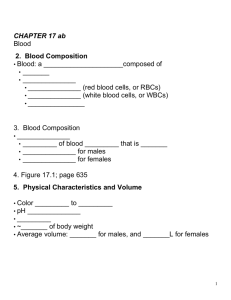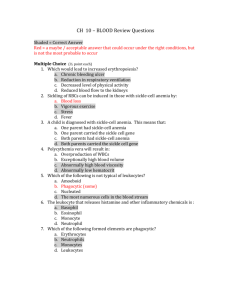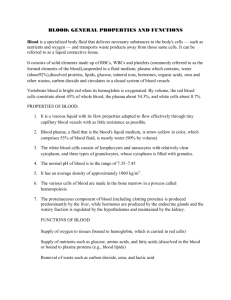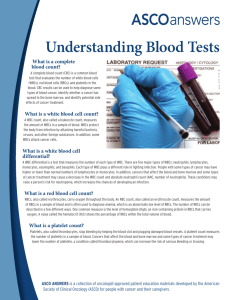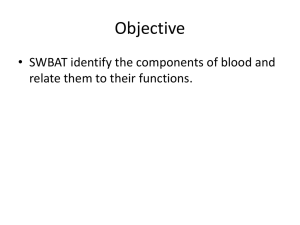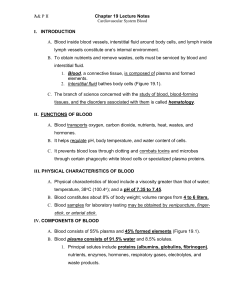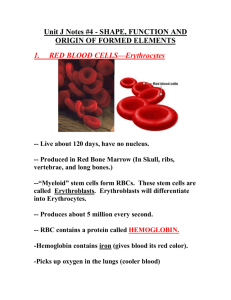Chapter 1. Blood and the cells it contains
advertisement
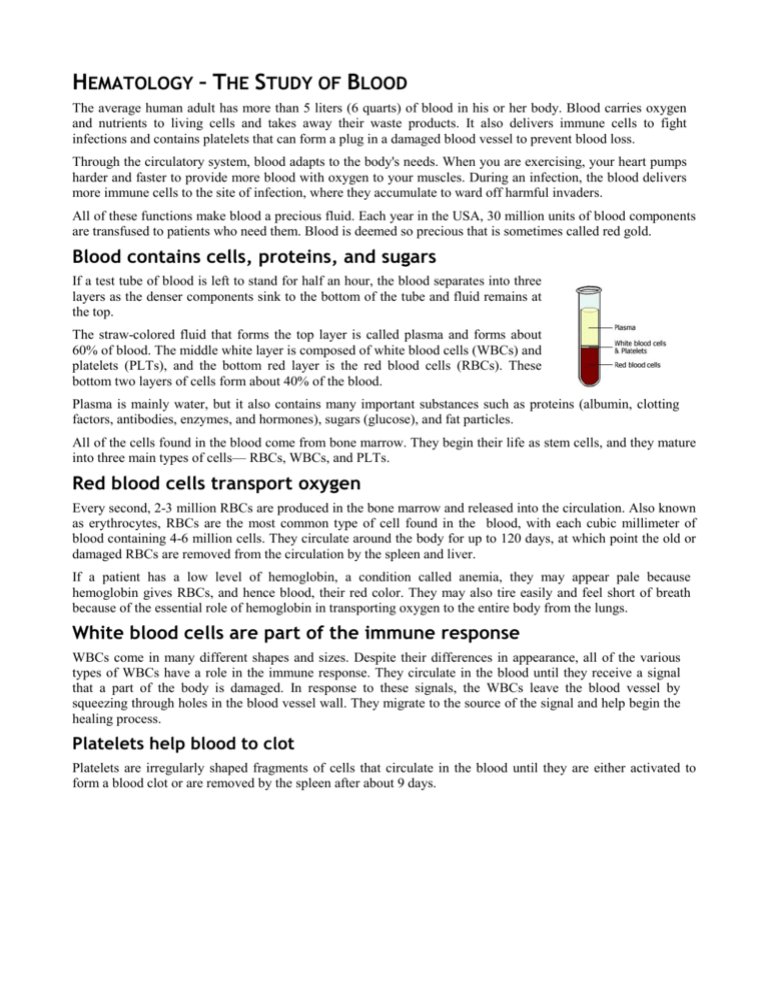
HEMATOLOGY – THE STUDY OF BLOOD The average human adult has more than 5 liters (6 quarts) of blood in his or her body. Blood carries oxygen and nutrients to living cells and takes away their waste products. It also delivers immune cells to fight infections and contains platelets that can form a plug in a damaged blood vessel to prevent blood loss. Through the circulatory system, blood adapts to the body's needs. When you are exercising, your heart pumps harder and faster to provide more blood with oxygen to your muscles. During an infection, the blood delivers more immune cells to the site of infection, where they accumulate to ward off harmful invaders. All of these functions make blood a precious fluid. Each year in the USA, 30 million units of blood components are transfused to patients who need them. Blood is deemed so precious that is sometimes called red gold. Blood contains cells, proteins, and sugars If a test tube of blood is left to stand for half an hour, the blood separates into three layers as the denser components sink to the bottom of the tube and fluid remains at the top. The straw-colored fluid that forms the top layer is called plasma and forms about 60% of blood. The middle white layer is composed of white blood cells (WBCs) and platelets (PLTs), and the bottom red layer is the red blood cells (RBCs). These bottom two layers of cells form about 40% of the blood. Plasma is mainly water, but it also contains many important substances such as proteins (albumin, clotting factors, antibodies, enzymes, and hormones), sugars (glucose), and fat particles. All of the cells found in the blood come from bone marrow. They begin their life as stem cells, and they mature into three main types of cells— RBCs, WBCs, and PLTs. Red blood cells transport oxygen Every second, 2-3 million RBCs are produced in the bone marrow and released into the circulation. Also known as erythrocytes, RBCs are the most common type of cell found in the blood, with each cubic millimeter of blood containing 4-6 million cells. They circulate around the body for up to 120 days, at which point the old or damaged RBCs are removed from the circulation by the spleen and liver. If a patient has a low level of hemoglobin, a condition called anemia, they may appear pale because hemoglobin gives RBCs, and hence blood, their red color. They may also tire easily and feel short of breath because of the essential role of hemoglobin in transporting oxygen to the entire body from the lungs. White blood cells are part of the immune response WBCs come in many different shapes and sizes. Despite their differences in appearance, all of the various types of WBCs have a role in the immune response. They circulate in the blood until they receive a signal that a part of the body is damaged. In response to these signals, the WBCs leave the blood vessel by squeezing through holes in the blood vessel wall. They migrate to the source of the signal and help begin the healing process. Platelets help blood to clot Platelets are irregularly shaped fragments of cells that circulate in the blood until they are either activated to form a blood clot or are removed by the spleen after about 9 days. COMPLETE BLOOD COUNT A complete blood count (CBC) is a simple blood test that is commonly ordered as part of a routine medical assessment. As the name suggests, it is a count of the different types of cells found in the blood. The test can diagnose and monitor many different diseases, such as anemia, infection, inflammatory diseases, and malignancy. Table 1 gives an example of CBC values Table 1 – Components of the complete blood count (CBC) Normal CBC Value Amount in Just 1 mL of Blood Population Equivalent WBCs 4.5-11 K/uL ~7,000,000 in 1 mL SF Bay Area RBCs 3.5-5.5 million/uL ~5,000,000,000 in 1 mL Entire World ~300,000,000 in 1 mL United States • Hb 13 - 18 g/dL • HCT 45% to 52% PLTs 150-400 K/uL WBCs – the number of White Blood Cells; RBCs - the number of Red Blood Cells.; Hb - the total amount of Hemoglobin (Hb) in the blood; HCT - the amount of space RBCs take up in the blood also known as Hematocrit.; PLTs - number of platelets The number of WBCs increases in infection and tumors An increased number of WBCs is most commonly caused by infections. It may also be caused by WBC cancers, such as leukemia. A decreased number of WBCs is caused by the bone marrow failing to produce WBCs or by an increased removal of WBCs from the circulation by a diseased liver or an overactive spleen. Bone marrow failure may be caused by toxins or by the normal bone marrow cells being replaced by tumor cells. RBC count detects anemia Anemia is a medical condition in which the red blood cell count or hemoglobin is less than normal. Anemia is caused through two basic pathways 1) by a decrease in production of red blood cell or hemoglobin, or 2) by a loss or destruction of red blood cells. • Hematocrit is the percentage of RBCs in the total volume of blood The hematocrit measures the fraction of the blood that is made up of RBCs. It reflects the combination of the total number of RBCs, and the volume that they occupy. • Hemoglobin binds oxygen Hemoglobin is the oxygen-carrying protein that is found within all RBCs. It picks up oxygen where it is abundant (the lungs) and drops off oxygen where it is needed around the body. Hemoglobin is also the pigment that gives RBCs their red color. The number PLTs detects thrombocytopenia Thrombocytopenia is a condition of low levels of platelets and carries an increased risk of bleeding. A high level of platelets (thrombocythemia) carries an increased risk of forming inappropriate blood clots. These clots could deprive essential organs such as the heart and brain, of their blood supply, causing heart attacks and strokes, respectively. BLOOD SMEARS A peripheral blood smear is often used as a follow-up test to abnormal results on a complete blood count (CBC). Blood smears are generated by taking one drop of blood and smearing it across a glass slide then treating the smear with a stain (Wright-Giemsa) that makes the differences in the blood cells more apparent. It may be used to help diagnose and/or monitor numerous conditions that affect blood cell populations. A blood smear is often used to categorize and/or identify conditions that affect one or more types of blood cells and to monitor those undergoing treatment for these conditions. You can see all three blood components in a smear. (Panels A-C). A Normal B C GENETIC DISEASE OF THE BLOOD RBC Disorders - Hemoglobinopathies Hemoglobinopathies form a group of inherited diseases that are caused by mutations in hemoglobin. Sickle cell anemia is the most common of these and is attributable to a mutation that changes one of the amino acids in the hemoglobin, producing hemoglobin that is "fragile". Sickle patient RBCs tend to become distorted and "sickle" shaped on a blood smear (See panel B and C). These deformed cells can block small blood vessels and damage the organs they are supplying. This can be very painful, and if not treated, a sickle cell crisis can be fatal. Another inherited anemia that particularly affects individuals of Eastern descent is thalassemia. A fault in the production of either alpha or beta globin chains causes a range of symptoms, depending on how many copies of the alpha and beta genes are affected. Some individuals may be carriers of the disease and have no symptoms, whereas if all copies of the genes are lost, the disease is fatal. Patients with many hemoglobinopathies have reduced hemoglobin, appear pale, have enlarged spleens, and complain of being tired. D Sickle 40x E Sickle 100x F Thalassemia WBC Disorders - Leukemia As do most cancers, leukemia strikes sporadically. Though hereditary influences or environmental exposures may contribute to risk, its occurrence is usually considered random. For some rare families, however, the disease is hereditary. In only a few dozen known cases, parents pass it to their offspring as a single gene. Leukemia is a type of cancer of the blood or bone marrow characterized by an abnormal increase of immature white blood cells called "blasts" (See panel G and H). Leukemia is a broad term covering a spectrum of diseases. G H PLT Disorders - Thrombocytopenia Most thrombocytopenia (Panel I) cases do not have a genetic component; however, there are several genetic disorders that affect blood clotting. Von Willebrand disease (vWD) is the most common hereditary blood clotting disorder. It arises from a deficiency of von Willebrand factor, a protein that is required for platelet binding. Hemophilia is another group of hereditary genetic disorders that impair the body's ability to control blood clotting. Hemophilias are usually X chromosome disorders that are more likely to occur in males than females. The PLTs count in vWD or Haemophilia patients are usually unaffected. I Normal Thrombocytopenia

